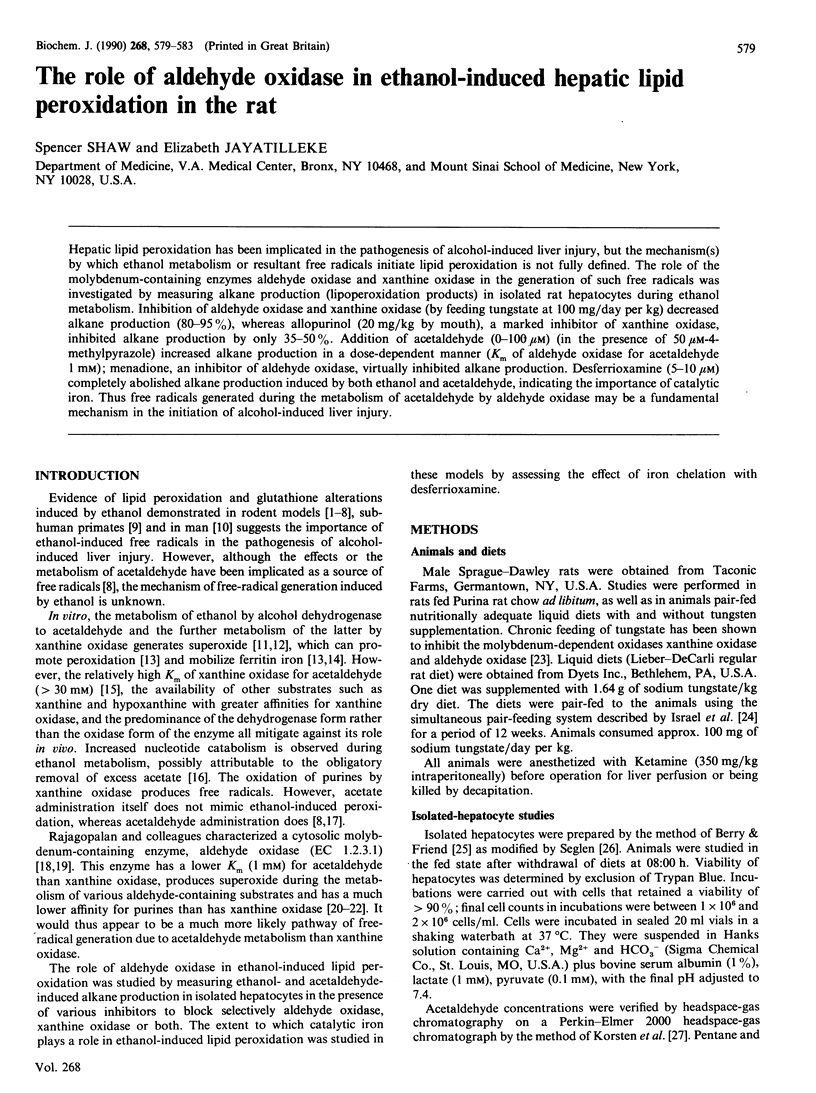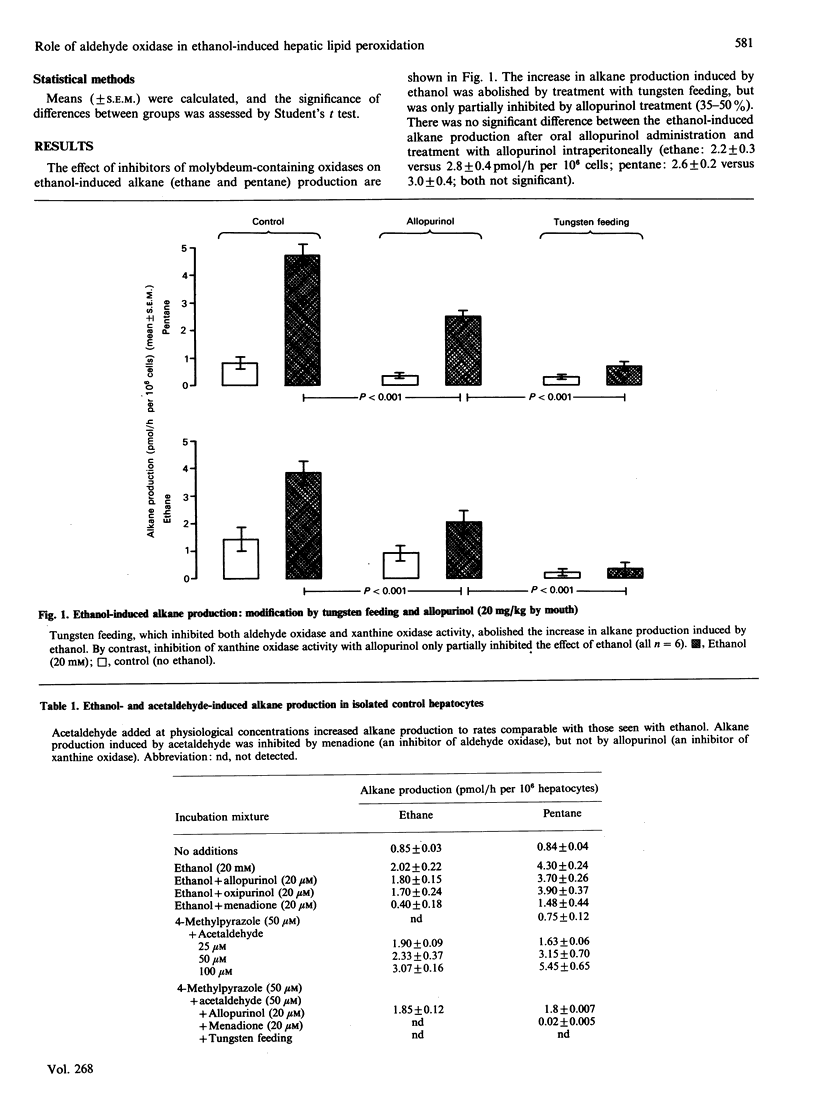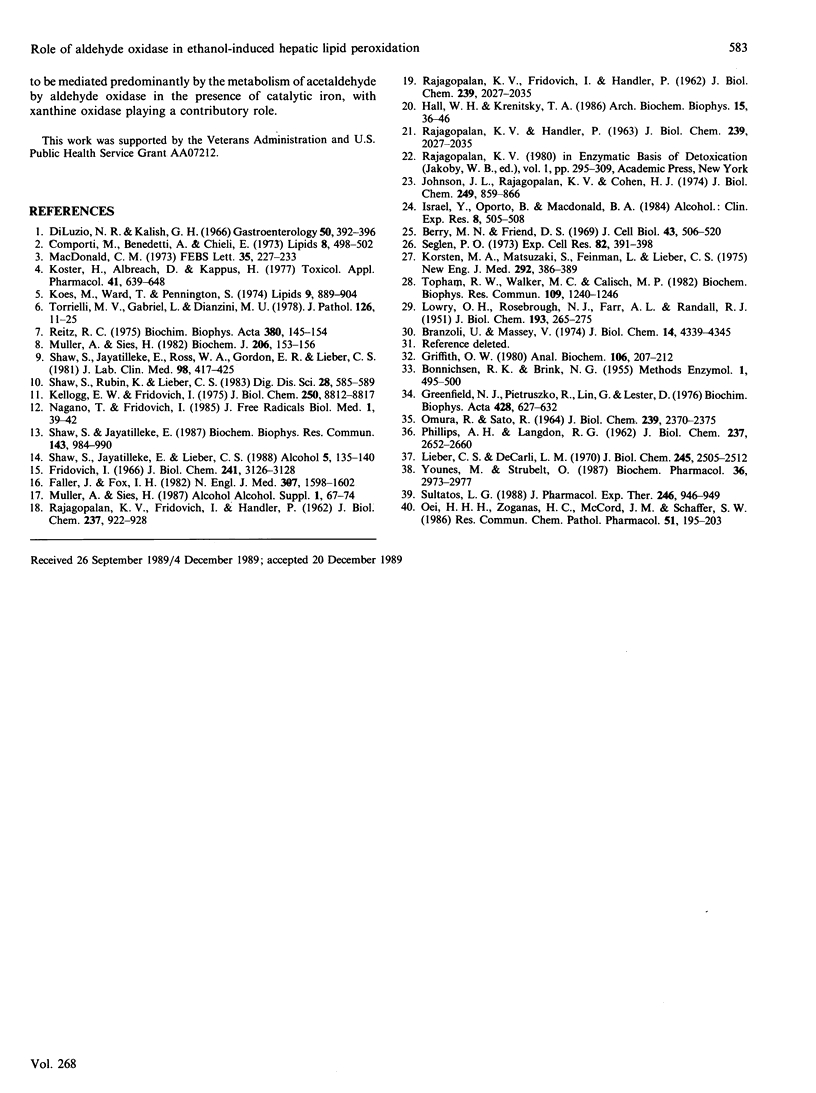Abstract
Hepatic lipid peroxidation has been implicated in the pathogenesis of alcohol-induced liver injury, but the mechanism(s) by which ethanol metabolism or resultant free radicals initiate lipid peroxidation is not fully defined. The role of the molybdenum-containing enzymes aldehyde oxidase and xanthine oxidase in the generation of such free radicals was investigated by measuring alkane production (lipoperoxidation products) in isolated rat hepatocytes during ethanol metabolism. Inhibition of aldehyde oxidase and xanthine oxidase (by feeding tungstate at 100 mg/day per kg) decreased alkane production (80-95%), whereas allopurinol (20 mg/kg by mouth), a marked inhibitor of xanthine oxidase, inhibited alkane production by only 35-50%. Addition of acetaldehyde (0-100 microM) (in the presence of 50 microM-4-methylpyrazole) increased alkane production in a dose-dependent manner (Km of aldehyde oxidase for acetaldehyde 1 mM); menadione, an inhibitor of aldehyde oxidase, virtually inhibited alkane production. Desferrioxamine (5-10 microM) completely abolished alkane production induced by both ethanol and acetaldehyde, indicating the importance of catalytic iron. Thus free radicals generated during the metabolism of acetaldehyde by aldehyde oxidase may be a fundamental mechanism in the initiation of alcohol-induced liver injury.
Full text
PDF




Selected References
These references are in PubMed. This may not be the complete list of references from this article.
- Berry M. N., Friend D. S. High-yield preparation of isolated rat liver parenchymal cells: a biochemical and fine structural study. J Cell Biol. 1969 Dec;43(3):506–520. doi: 10.1083/jcb.43.3.506. [DOI] [PMC free article] [PubMed] [Google Scholar]
- Branzoli U., Massey V. Preparation of aldehyde oxidase in its native and deflavo forms. Comparison of spectroscopic and catalytic properties. J Biol Chem. 1974 Jul 25;249(14):4399–4345. [PubMed] [Google Scholar]
- Comporti M., Benedetti A., Chieli E. Studies on in vitro peroxidation of liver lipids in ethanol-treated rats. Lipids. 1973 Sep;8(9):498–502. doi: 10.1007/BF02531984. [DOI] [PubMed] [Google Scholar]
- Faller J., Fox I. H. Ethanol-induced hyperuricemia: evidence for increased urate production by activation of adenine nucleotide turnover. N Engl J Med. 1982 Dec 23;307(26):1598–1602. doi: 10.1056/NEJM198212233072602. [DOI] [PubMed] [Google Scholar]
- Fridovich I. The mechanism of the enzymatic oxidation of aldehydes. J Biol Chem. 1966 Jul 10;241(13):3126–3128. [PubMed] [Google Scholar]
- Greenfield N. J., Pietruszko R., Lin G., Lester D. The effect of ethanol ingestion on the aldehyde dehydrogenases of rat liver. Biochim Biophys Acta. 1976 May 28;428(3):627–632. doi: 10.1016/0304-4165(76)90191-4. [DOI] [PubMed] [Google Scholar]
- Griffith O. W. Determination of glutathione and glutathione disulfide using glutathione reductase and 2-vinylpyridine. Anal Biochem. 1980 Jul 15;106(1):207–212. doi: 10.1016/0003-2697(80)90139-6. [DOI] [PubMed] [Google Scholar]
- Hall W. W., Krenitsky T. A. Aldehyde oxidase from rabbit liver: specificity toward purines and their analogs. Arch Biochem Biophys. 1986 Nov 15;251(1):36–46. doi: 10.1016/0003-9861(86)90048-2. [DOI] [PubMed] [Google Scholar]
- Israel Y., Oporto B., Macdonald A. D. Simultaneous pair-feeding system for the administration of alcohol-containing liquid diets. Alcohol Clin Exp Res. 1984 Sep-Oct;8(5):505–508. doi: 10.1111/j.1530-0277.1984.tb05714.x. [DOI] [PubMed] [Google Scholar]
- Johnson J. L., Rajagopalan K. V., Cohen H. J. Molecular basis of the biological function of molybdenum. Effect of tungsten on xanthine oxidase and sulfite oxidase in the rat. J Biol Chem. 1974 Feb 10;249(3):859–866. [PubMed] [Google Scholar]
- Kellogg E. W., 3rd, Fridovich I. Superoxide, hydrogen peroxide, and singlet oxygen in lipid peroxidation by a xanthine oxidase system. J Biol Chem. 1975 Nov 25;250(22):8812–8817. [PubMed] [Google Scholar]
- Koes M., Ward T., Pennington S. Lipid peroxidation in chronic ethanol treated rats: in vitro uncoupling of peroxidation from reduced nicotine adenosine dinucleotide phosphate oxidation. Lipids. 1974 Nov;9(11):899–904. doi: 10.1007/BF02532616. [DOI] [PubMed] [Google Scholar]
- Korsten M. A., Matsuzaki S., Feinman L., Lieber C. S. High blood acetaldehyde levels after ethanol administration. Difference between alcoholic and nonalcoholic subjects. N Engl J Med. 1975 Feb 20;292(8):386–389. doi: 10.1056/NEJM197502202920802. [DOI] [PubMed] [Google Scholar]
- Köster U., Albrecht D., Kappus H. Evidence for carbon tetrachloride- and ethanol-induced lipid peroxidation in vivo demonstrated by ethane production in mice and rats. Toxicol Appl Pharmacol. 1977 Sep;41(3):639–648. doi: 10.1016/s0041-008x(77)80017-3. [DOI] [PubMed] [Google Scholar]
- LOWRY O. H., ROSEBROUGH N. J., FARR A. L., RANDALL R. J. Protein measurement with the Folin phenol reagent. J Biol Chem. 1951 Nov;193(1):265–275. [PubMed] [Google Scholar]
- Lieber C. S., DeCarli L. M. Hepatic microsomal ethanol-oxidizing system. In vitro characteristics and adaptive properties in vivo. J Biol Chem. 1970 May 25;245(10):2505–2512. [PubMed] [Google Scholar]
- MacDonald C. M. The effects of ethanol on hepatic lipid peroxidation and on the activities of glutathione reductase and peroxidase. FEBS Lett. 1973 Sep 15;35(2):227–230. doi: 10.1016/0014-5793(73)80291-1. [DOI] [PubMed] [Google Scholar]
- Müller A., Sies H. Alcohol, aldehydes and lipid peroxidation: current notions. Alcohol Alcohol Suppl. 1987;1:67–74. [PubMed] [Google Scholar]
- Müller A., Sies H. Role of alcohol dehydrogenase activity and the acetaldehyde in ethanol- induced ethane and pentane production by isolated perfused rat liver. Biochem J. 1982 Jul 15;206(1):153–156. doi: 10.1042/bj2060153. [DOI] [PMC free article] [PubMed] [Google Scholar]
- Nagano T., Fridovich I. Superoxide radical from xanthine oxidase acting upon lumazine. J Free Radic Biol Med. 1985;1(1):39–42. doi: 10.1016/0748-5514(85)90027-3. [DOI] [PubMed] [Google Scholar]
- OMURA T., SATO R. THE CARBON MONOXIDE-BINDING PIGMENT OF LIVER MICROSOMES. I. EVIDENCE FOR ITS HEMOPROTEIN NATURE. J Biol Chem. 1964 Jul;239:2370–2378. [PubMed] [Google Scholar]
- Oei H. H., Zoganas H. C., McCord J. M., Schaffer S. W. Role of acetaldehyde and xanthine oxidase in ethanol-induced oxidative stress. Res Commun Chem Pathol Pharmacol. 1986 Feb;51(2):195–203. [PubMed] [Google Scholar]
- PHILLIPS A. H., LANGDON R. G. Hepatic triphosphopyridine nucleotide-cytochrome c reductase: isolation, characterization, and kinetic studies. J Biol Chem. 1962 Aug;237:2652–2660. [PubMed] [Google Scholar]
- RAJAGOPALAN K. V., FRIDOVICH I., HANDLER P. Hepatic aldehyde oxidase. I. Purification and properties. J Biol Chem. 1962 Mar;237:922–928. [PubMed] [Google Scholar]
- RAJAGOPALAN K. V., HANDLER P. HEPATIC ALDEHYDE OXIDASE. 3. THE SUBSTRATE-BINDING SITE. J Biol Chem. 1964 Jun;239:2027–2035. [PubMed] [Google Scholar]
- RAJAGOPALAN K. V., HANDLER P. HEPATIC ALDEHYDE OXIDASE. 3. THE SUBSTRATE-BINDING SITE. J Biol Chem. 1964 Jun;239:2027–2035. [PubMed] [Google Scholar]
- Reitz R. C. A possible mechanism for the peroxidation of lipids due to chronic ethanol ingestion. Biochim Biophys Acta. 1975 Feb 20;380(2):145–154. doi: 10.1016/0005-2760(75)90001-6. [DOI] [PubMed] [Google Scholar]
- Seglen P. O. Preparation of rat liver cells. 3. Enzymatic requirements for tissue dispersion. Exp Cell Res. 1973 Dec;82(2):391–398. doi: 10.1016/0014-4827(73)90357-1. [DOI] [PubMed] [Google Scholar]
- Shaw S., Jayatilleke E. Acetaldehyde-mediated hepatic lipid peroxidation: role of superoxide and ferritin. Biochem Biophys Res Commun. 1987 Mar 30;143(3):984–990. doi: 10.1016/0006-291x(87)90348-2. [DOI] [PubMed] [Google Scholar]
- Shaw S., Jayatilleke E., Lieber C. S. Lipid peroxidation as a mechanism of alcoholic liver injury: role of iron mobilization and microsomal induction. Alcohol. 1988 Mar-Apr;5(2):135–140. doi: 10.1016/0741-8329(88)90010-9. [DOI] [PubMed] [Google Scholar]
- Shaw S., Jayatilleke E., Ross W. A., Gordon E. R., Leiber C. S. Ethanol-induced lipid peroxidation: potentiation by long-term alcohol feeding and attenuation by methionine. J Lab Clin Med. 1981 Sep;98(3):417–424. [PubMed] [Google Scholar]
- Shaw S., Rubin K. P., Lieber C. S. Depressed hepatic glutathione and increased diene conjugates in alcoholic liver disease. Evidence of lipid peroxidation. Dig Dis Sci. 1983 Jul;28(7):585–589. doi: 10.1007/BF01299917. [DOI] [PubMed] [Google Scholar]
- Sultatos L. G. Effects of acute ethanol administration on the hepatic xanthine dehydrogenase/oxidase system in the rat. J Pharmacol Exp Ther. 1988 Sep;246(3):946–949. [PubMed] [Google Scholar]
- Topham R. W., Walker M. C., Calisch M. P. Liver xanthine dehydrogenase and iron mobilization. Biochem Biophys Res Commun. 1982 Dec 31;109(4):1240–1246. doi: 10.1016/0006-291x(82)91910-6. [DOI] [PubMed] [Google Scholar]
- Torrielli M. V., Gabriel L., Dianzani M. U. Ethanol-induced hepatotoxicity; experimental observations on the role of lipid peroxidation. J Pathol. 1978 Sep;126(1):11–25. doi: 10.1002/path.1711260103. [DOI] [PubMed] [Google Scholar]
- Younes M., Strubelt O. Enhancement of hypoxic liver damage by ethanol. Involvement of xanthine oxidase and the role of glycolysis. Biochem Pharmacol. 1987 Sep 15;36(18):2973–2977. doi: 10.1016/0006-2952(87)90211-5. [DOI] [PubMed] [Google Scholar]


